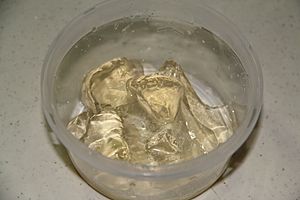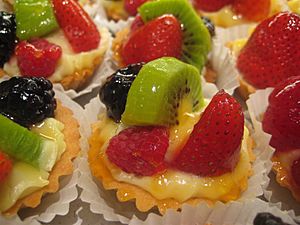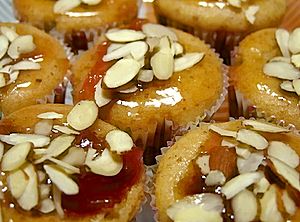Nappage facts for kids
Nappage (say "nap-pahj") is a special clear coating used in baking. You might also hear it called jam glaze or apricot glaze. It's a French word that means 'coating' or 'topping'. Bakers use nappage to make yummy pastries look even better.
Contents
What is Nappage?
Nappage is a type of glaze. It's put on top of fruit on things like fruit tarts or other baked treats. Its main job is to make the fruit look super shiny. It also helps stop the fruit from drying out. Plus, it keeps the fruit from changing color too quickly.
Why Use Nappage?
Imagine a beautiful fruit tart. The fruit on top can look a bit dull. Nappage makes it sparkle! It gives a lovely, glossy finish. This makes the pastry look fresh and appealing. It also protects the fruit. It forms a thin layer that keeps air away. This stops the fruit from getting dry. It also helps prevent "oxidation," which is when fruit turns brown.
What is Pectin?
The main ingredient that makes nappage work is pectin. Pectin is a natural gelling agent. This means it helps things turn into a jelly-like substance. You can find pectin naturally in many fruits. It's what makes jams and jellies set. In nappage, pectin helps create that clear, shiny coating.
How Nappage is Made
There are a few ways to make nappage. The most common way uses fruit.
Traditional Apricot Glaze
Traditionally, nappage is made from apricot jam. The jam is mixed with water. This makes a clear, slightly apricot-colored glaze. It's simple and gives a nice shine. Sometimes, bakers use redcurrant jelly instead. This is especially good if they want to make red fruits look even brighter.
Making a Neutral Glaze
You can also make a "neutral" nappage. This kind doesn't have an apricot flavor. To make it, pure pectin is mixed with water. A little citric acid (or lemon juice) is added. This mixture is then heated to about 45°C (113°F). Heating helps the pectin turn into a gel. Once it's a gel, you can add different flavors or colors to it. This is useful for many types of pastries.
Some special pectin, called Pectin NH, is often used. It's "thermoreversible." This means it can be heated and cooled many times. It will set into a gel when cool. Then it will melt back into a liquid when heated. This is very handy for bakeries. They can make big batches and reuse it.
How to Apply Nappage
Applying nappage is easy. Bakers usually use a pastry brush. They gently dab the glaze onto the fruit. It's better to dab than to brush. This helps make sure the coat is even. Nappage is usually applied when it's cool. It works best on cold fruits. If the fruit is warm, the nappage can be applied warm too. It will then thicken into a gel as it cools down.




